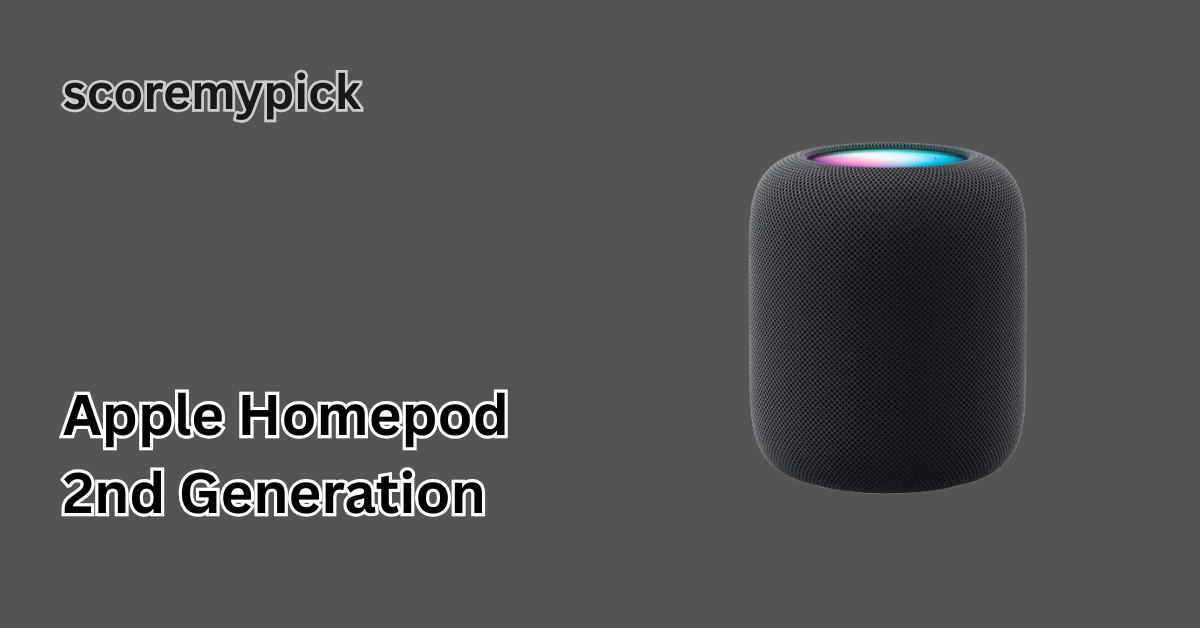Apple has been a company known for integrating technology and design, and the Apple HomePod 2nd Generation is no exception. Following the cancellation of the initial one in 2021, numerous people believed that Apple was no longer active in the smart speaker market.
In 2023, however, Apple has shocked the world with a well-finished model that promises not only to be better sounding but also brighter than ever, integrating seamlessly into the Apple ecosystem. This is a critical analysis of its design, features, sound performance, and whether it has really made a splash in the competitive smart speaker market or not.
Apple HomePod 2nd Generation Design and Build Quality
The Apple HomePod 2nd Generation retains the classic cylindrical design with minor design tweaks that have made it appear more classy. The speaker itself is coated in a smooth mesh and can be purchased in two different colors, Midnight and White, both of which mesh fabric completely merges into modern interiors.
It is only slightly over 6.6 inches tall, with a mass of approximately 5.16 pounds, which means that it is not very large but is still heavy enough to indicate the quality of the construction.
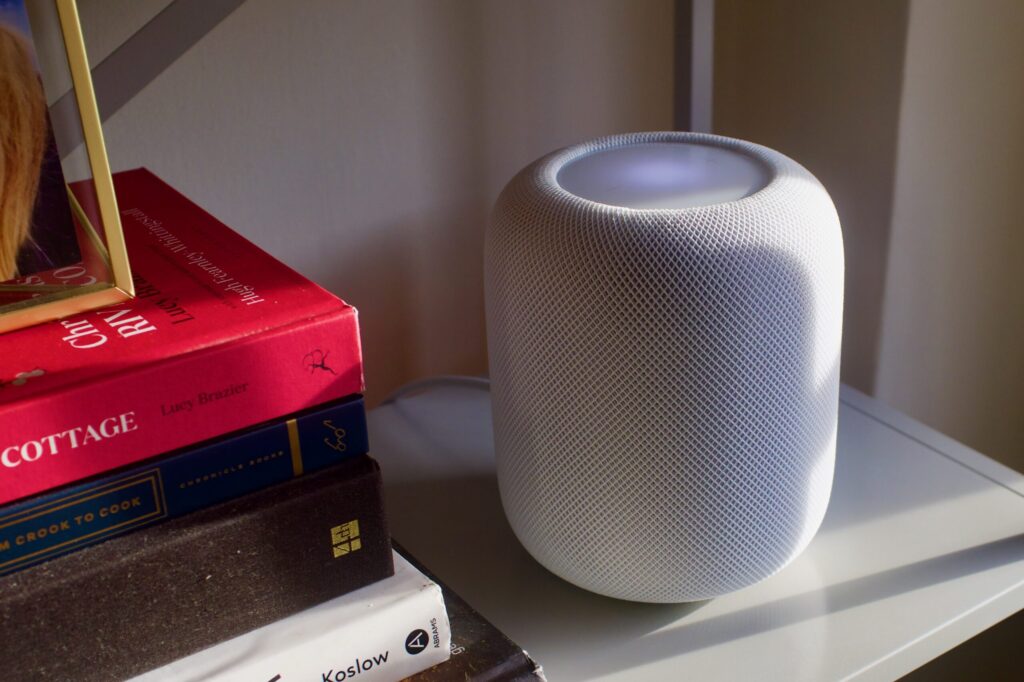
The touch surface on the top has been improved, and it now has the capability of providing a complete backlight to make it easier to interact with Siri and playback controls. Compared to most plastic-intensive smart speakers, Apple’s design is luxurious, with consideration given to both style and sound quality.
Durability also shines here. The mesh is also aesthetically pleasing, as it is acoustically transparent, allowing for no sound distortion. This time, the power cable is removable, and it is one of the considerate additions compared to the original HomePod.
Apple has clearly focused on making the HomePod 2nd Gen a speaker that doesn’t just play music but also doubles as a statement piece in your living room.
Sound Performance and Audio Features
When it comes to audio quality, the Apple HomePod 2nd Generation sets a new benchmark in the smart speaker category. Equipped with a high-excursion woofer, a powerful diaphragm capable of 20mm movement, and five beamforming tweeters, this device delivers room-filling, immersive sound.
Computational audio, driven by a custom Apple S7 chip, is one of its best components. This technology continuously scans the music and modulates the sound in real-time to make sure that the vocals of the music are crisp, the bass is deep, and the overall effect is balanced. The HomePod also does not just get loud, like most competitors, but is also able to stay clear even when it is blasting.
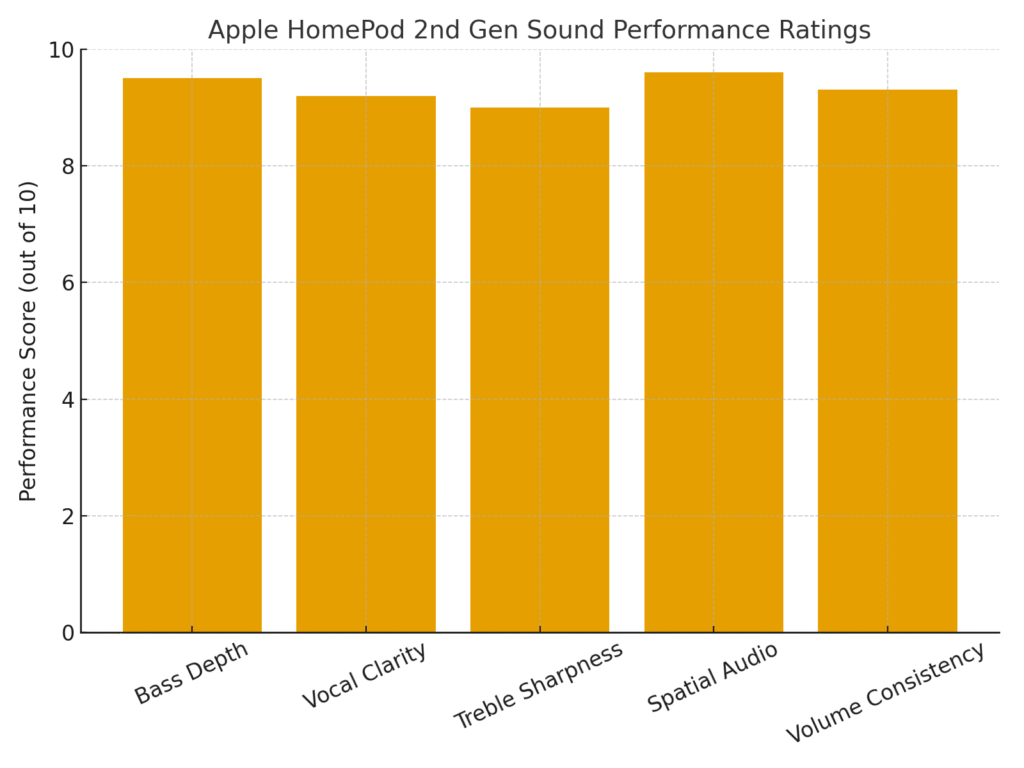
The listening experience is also improved in the room-sensing technology. It features built-in microphones that automatically detect the speaker’s position, whether against a wall or in an open area, and optimize the sound accordingly. This means that you receive customized audio regardless of where you place it.
For those who love multi-speaker setups, the HomePod 2 supports stereo pairing and multiroom audio with AirPlay 2, making it perfect for creating a cinema-like experience at home.
Add Spatial Audio with Dolby Atmos, and you’ll notice how soundtracks, vocals, and instruments seem to float around you—especially when paired with Apple TV 4K.
Smart Features and Siri Integration
Beyond sound, the Apple HomePod 2nd Gen shines as a smart home hub. Powered by Siri, it allows hands-free control of your smart devices, from adjusting the lights and thermostat to locking doors or checking the weather. Apple has integrated Matter support, making it compatible with a wide range of smart home accessories across brands.
The speaker also features built-in temperature and humidity sensors, providing users with real-time climate updates and enabling automation. For example, you can set Siri to turn on a fan when the room temperature crosses a certain level.
Music lovers will appreciate the seamless Apple Music integration, but the HomePod also supports third-party services like Pandora, Deezer, and iHeartRadio. However, Spotify integration still feels limited compared to Apple Music.
Privacy, a core Apple promise, is also strong here. Voice requests are processed on-device whenever possible, and your personal data is not sold to advertisers.
In short, the HomePod 2nd Generation isn’t just a speaker—it’s a complete intelligent assistant designed to blend into your daily life.
Connectivity, Compatibility, and Setup Experience
Apple has streamlined the HomePod 2nd Generation setup process to be as effortless as possible. Once plugged in, it automatically appears on your iPhone or iPad screen for quick pairing, much like AirPods. Within a few taps, it’s ready to use.
HomePod is compatible with Wi-Fi 4, Bluetooth 5.0, Ultra Wideband (UWB), and, of course, AirPlay 2, which facilitates comfortable streaming between Apple devices. It is also compatible with HomeKit accessories, allowing you to have centralized control of your smart home.
The compatibility is best in the Apple environment. It will perfectly fit in with the iPhone, iPad, Mac, and Apple TV users. Features such as Handoff enable you to pass what you are listening to on your iPhone to the HomePod by simply placing the devices together.
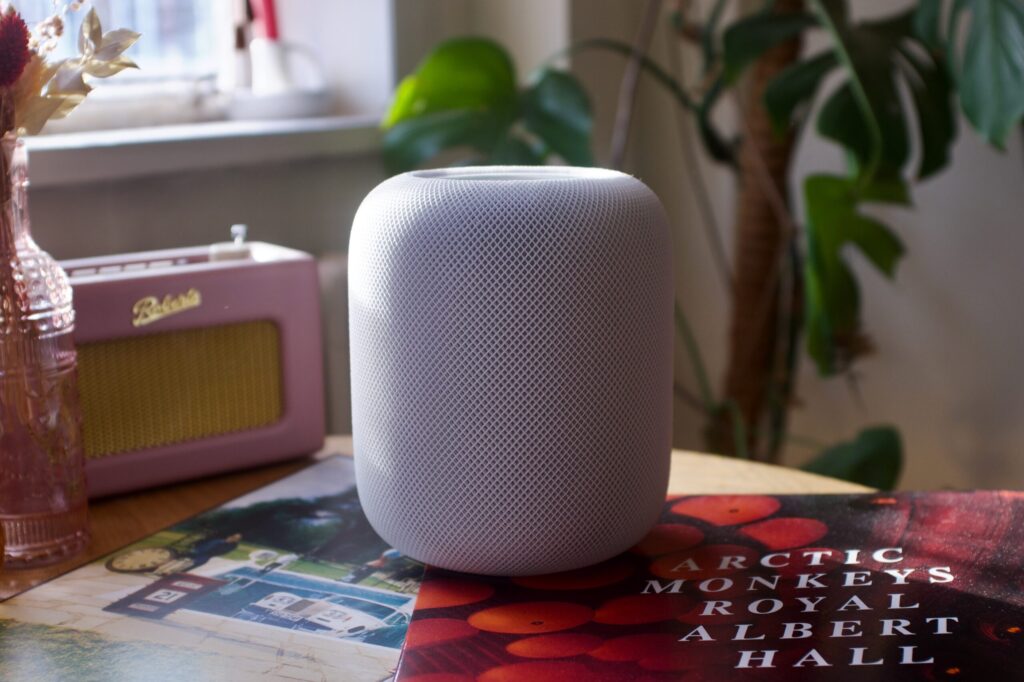
To non-Apple users, there is a restriction of functionality. Although AirPlay is compatible with a few third-party applications, HomePod 2nd Gen is obviously designed to appeal to the user who is an avid Apple product user. With that said, supported by Matter, it now interoperates with more smart home devices than it did with the HomePod original.
In short, connectivity is smooth, fast, and reliable—though best experienced if you’re already in the Apple ecosystem.
Comparison: Apple HomePod 2nd Generation vs Other Smart Speakers
When placed side by side with rivals like the Amazon Echo Studio and Google Nest Audio, the HomePod 2nd Generation immediately stands out in terms of audio performance. While the Echo and Nest speakers focus heavily on AI assistants and innovative features, Apple takes a different approach by prioritizing sound quality.
- Sound Quality: The HomePod delivers richer bass and more transparent mids compared to both the Echo and Nest. The Echo Studio offers good 3D audio, but Apple’s Spatial Audio with Dolby Atmos feels more immersive.
- Innovative Features: Alexa outshines Siri in terms of versatility and third-party integrations, while Google Assistant offers more thoughtful responses. However, Apple has narrowed the gap with improved Siri capabilities and the addition of Matter support.
- Design: HomePod maintains a more premium, minimalist design compared to the industrial look of the Echo or the fabric-covered Nest Audio.
- Ecosystem Integration: If you’re an Apple user, the HomePod is unmatched. Features like Handoff, AirPlay 2, and Apple TV 4K integration make it a perfect companion. For Android users, however, the Echo or Nest may be more practical.
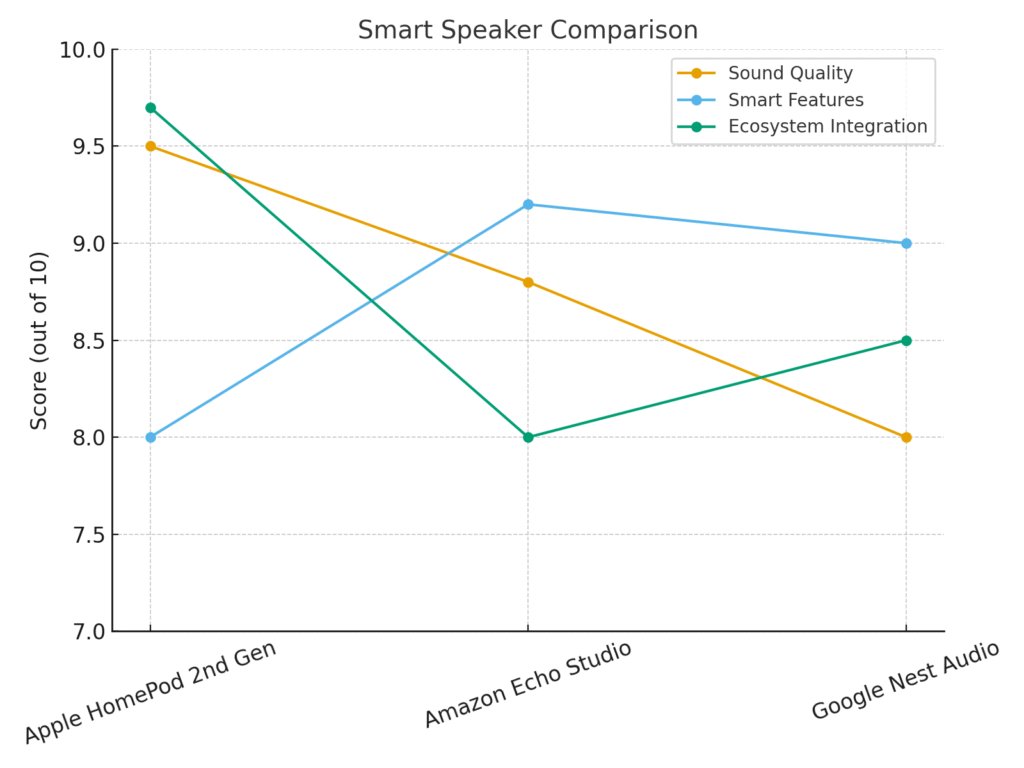
Ultimately, if sound quality and Apple ecosystem synergy are your top priorities, the HomePod 2nd Generation wins easily. But if you value affordability and universal innovative assistant capabilities, Amazon or Google may suit you better.
Price, Value, and Who Should Buy It
The Apple HomePod 2nd Generation is priced at $299, placing it in the premium smart speaker category. While this may seem steep compared to Amazon Echo or Google Nest devices, it’s essential to understand what you’re paying for. Apple positions the HomePod not just as an intelligent assistant but as a high-quality audio system combined with advanced home automation features.
For music enthusiasts, the sound quality alone justifies the price. The powerful woofer, five tweeters, and real-time tuning create a listening experience you won’t find in budget smart speakers.
For Apple ecosystem users, features like Handoff, AirPlay 2, and Apple TV 4K integration add even more value, making it feel like a natural extension of your devices.
However, if your primary goal is to control smart devices or ask general assistant questions, a cheaper Amazon Echo or Google Nest might serve you as well. The HomePod shines brightest when paired with other Apple products and when sound performance is a top priority.
In essence, this is the smart speaker for audiophiles and Apple loyalists—not necessarily for casual users who want just basic innovative features at a lower price point.
Final Words
The Apple HomePod 2nd Generation is Apple’s statement that premium design, immersive sound, and innovative features can coexist in one elegant device. It brings back everything users loved about the original model, while fixing past limitations with improved connectivity, Matter support, and environmental sensors.
Its strengths, such as outstanding sound quality, smooth integration with the Apple ecosystem, and support of Spatial Audio, make it among the best-sounding smart speakers of this day. On the other hand, a few buyers might be deterred by its limited compatibility with non-Apple devices and higher price.
The HomePod 2nd Gen is one of the best options that Apple users can make in 2025, and that is not because of sound but because of smart home control. In the case of all other people, it is the value of sound over versatility.
To sum up, the Apple HomePod 2nd Generation is not just an ordinary speaker; it is a home hub, offering high-quality sound with the intelligence of the Apple ecosystem.
FAQs
Is the Apple HomePod 2nd generation any good?
Yes, the Apple HomePod 2nd Generation is excellent, offering premium sound quality, innovative features, and seamless integration with the Apple ecosystem. It’s one of the best smart speakers for Apple users.
Which is better, HomePod 1 or 2?
The HomePod 2 improves on the original with better sound tuning, Matter support, built-in temperature sensors, and a detachable power cable, making it more advanced and versatile.
Can I use HomePod 2 as a TV speaker?
Yes, when paired with Apple TV 4K, the HomePod 2 delivers immersive Spatial Audio and Dolby Atmos, making it an excellent option for a home theater setup.
Does HomePod 2 have good bass?
Absolutely. Its high-excursion woofer and advanced audio calibration provide deep, powerful bass without distortion, even at higher volumes.

